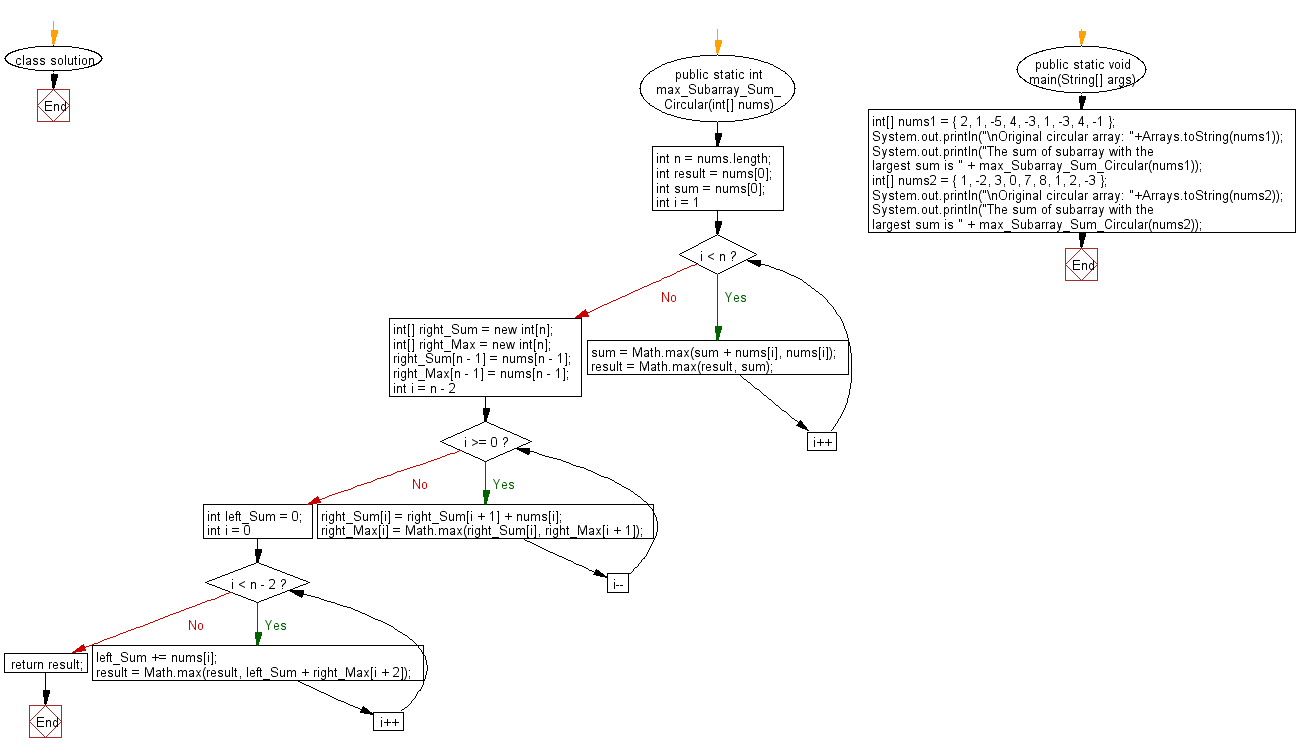Java: Find subarray which has the largest sum in a given circular array of integers
67. Find subarray with largest sum in a circular array
Write a Java program to find the subarray with the largest sum in a given circular array of integers.
Example:
Input :
nums1 = { 2, 1, -5, 4, -3, 1, -3, 4, -1 }
nums2 = { 1, -2, 3, 0, 7, 8, 1, 2, -3 }
Output:
The sum of subarray with the largest sum is 6
The sum of subarray with the largest sum is 21
Sample Solution:
Java Code:
// Import the necessary Java class.
import java.util.Arrays;
// Define a class named 'solution'.
class solution {
// Method to find the maximum sum of a subarray within a circular array.
public static int max_Subarray_Sum_Circular(int[] nums) {
int n = nums.length;
int result = nums[0]; // Initialize 'result' with the first element.
int sum = nums[0]; // Initialize 'sum' with the first element.
// Iterate through the array starting from the second element.
for (int i = 1; i < n; i++) {
// Calculate the maximum of 'sum + nums[i]' and 'nums[i]' (Kadane's algorithm).
sum = Math.max(sum + nums[i], nums[i]);
// Update 'result' with the maximum value.
result = Math.max(result, sum);
}
// Create arrays to store right sum and right max.
int[] right_Sum = new int[n];
int[] right_Max = new int[n];
// Initialize the last elements of right sum and right max arrays.
right_Sum[n - 1] = nums[n - 1];
right_Max[n - 1] = nums[n - 1];
// Iterate through the array in reverse order.
for (int i = n - 2; i >= 0; i--) {
// Calculate right sum and right max values.
right_Sum[i] = right_Sum[i + 1] + nums[i];
right_Max[i] = Math.max(right_Sum[i], right_Max[i + 1]);
}
int left_Sum = 0; // Initialize the left sum.
// Iterate through the array with a circular view, except the last two elements.
for (int i = 0; i < n - 2; i++) {
left_Sum += nums[i];
// Update 'result' with the maximum of 'left_Sum + right_Max[i + 2]' and the current 'result'.
result = Math.max(result, left_Sum + right_Max[i + 2]);
}
return result;
}
// Main method to demonstrate finding the maximum sum of a subarray in a circular array.
public static void main(String[] args) {
// Initialize two circular arrays.
int[] nums1 = { 2, 1, -5, 4, -3, 1, -3, 4, -1 };
int[] nums2 = { 1, -2, 3, 0, 7, 8, 1, 2, -3 };
// Print the original circular arrays.
System.out.println("\nOriginal circular array 1: " + Arrays.toString(nums1));
System.out.println("The sum of subarray with the largest sum is " + max_Subarray_Sum_Circular(nums1));
System.out.println("\nOriginal circular array 2: " + Arrays.toString(nums2));
System.out.println("The sum of subarray with the largest sum is " + max_Subarray_Sum_Circular(nums2));
}
}
Sample Output:
Original circular array: [2, 1, -5, 4, -3, 1, -3, 4, -1] The sum of subarray with the largest sum is 6 Original circular array: [1, -2, 3, 0, 7, 8, 1, 2, -3] The sum of subarray with the largest sum is 21
Flowchart:
For more Practice: Solve these Related Problems:
- Write a Java program to find the smallest subarray sum in a circular array.
- Write a Java program to find the maximum sum of a subarray that wraps around a circular array exactly once.
- Write a Java program to find the longest contiguous subarray with a sum greater than a given value in a circular array.
- Write a Java program to find the smallest contiguous subarray sum in a circular array.
Go to:
PREV : Find subarray with largest sum in a given array.
NEXT : Generate all permutations of a distinct integer array.
Java Code Editor:
What is the difficulty level of this exercise?
Test your Programming skills with w3resource's quiz.

